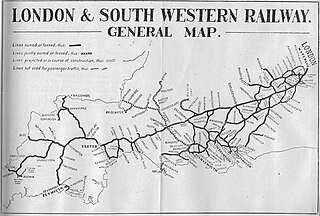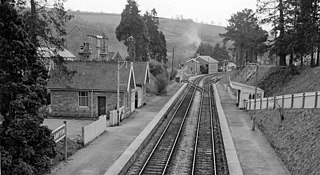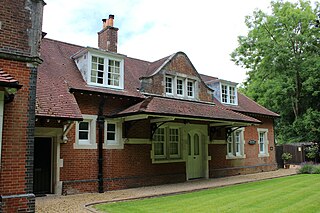
The London and South Western Railway was a railway company in England from 1838 to 1922. Originating as the London and Southampton Railway, its network extended to Dorchester and Weymouth, to Salisbury, Exeter and Plymouth, and to Padstow, Ilfracombe and Bude. It developed a network of routes in Hampshire, Surrey and Berkshire, including Portsmouth and Reading.

The Watercress Line is the marketing name of the Mid-Hants Railway, a heritage railway in Hampshire, England, running 10 miles (16 km) from New Alresford to Alton where it connects to the National Rail network. The line gained its popular name in the days when it was used to transport locally grown watercress to markets in London. The railway currently operates regular scheduled services, along with dining trains, real ale trains and numerous special events throughout the year.

The Mid-Hants Railway (MHR) originated when local people promoted a railway line between Alton and a junction near Winchester, connected to the larger London and South Western Railway at each end. It was authorised as the Alton, Alresford and Winchester Railway in 1861, and changed its name to the Mid-Hants Railway in 1865. It was opened for traffic in 1865. It was a single track 18 miles long, and had some very steep gradients. It had been unable to raise much share capital and it was heavily indebted from the outset, incurring heavy interest outlays.

Alton railway station serves the market town of Alton, in the English county of Hampshire. The station is the terminus for two railway lines: the Alton Line, which runs to Brookwood and on to London Waterloo, and the Mid Hants Watercress Railway which runs to Alresford. The latter once ran through to Winchester, but was closed to passengers in February 1973; it reopened as a heritage line in 1985. Two other routes, both now closed, also served the station: the Meon Valley line to Fareham and the Basingstoke and Alton Light Railway.

Fareham railway station is on the West Coastway Line, situated about 0.62 miles (1 km) from the town of Fareham in Hampshire, England. It is 84 miles 21 chains (135.6 km) down the line from London Waterloo.

Chapelton railway station serves the hamlet of Chapelton, part of the civil parish of Tawstock in the English county of Devon. It is a rural station on the Tarka Line to Barnstaple, 35 miles 52 chains (57.4 km) from Exeter Central at milepost 207 from London Waterloo. With just 142 passengers, it was the least used station in Devon in 2021-22.

West Meon is a village and civil parish in Hampshire, England, with a population of 749 people at the 2011 census.

Droxford is a village in Hampshire, England.

The Devon and Somerset Railway (D&SR) was a cross-country line that connected Barnstaple in Devon, England, to the network of the Bristol and Exeter Railway (B&ER) near Taunton. It was opened in stages between 1871 and 1873 and closed in 1966. It served a mostly rural area although it carried some through services from east of Taunton to the seaside resort of Ilfracombe.

The Basingstoke and Alton Light Railway was opened in 1901, by the London and South Western Railway. It was the first English railway authorised under Light Railway legislation. It ran through unpromising, lightly populated terrain, and was probably built only to exclude competitors from building a line in the area. It had steep gradients and a line speed limit of 20 mph, later raised to 25 mph.

Alton is a former railway station in Staffordshire, which served the village of Alton and the country estate at Alton Towers. Opened in 1849 by the North Staffordshire Railway, the station was a stop on the Churnet Valley line. In 1954, the station was renamed Alton Towers. After its closure in 1965, the station site was purchased by Staffordshire County Council in 1969 to curtail persistent vandalism of the station building. In 1979, it was sold to the Landmark Trust, who reverted the site's name back to Alton and converted the former station buildings into holiday accommodation.
The Meon Valley Railway was a cross-country railway in Hampshire, England, that ran for 22 miles (36 km) between Alton and Fareham, closely following the course of the River Meon. At its northern (Alton) end, it joined with the Alton Line from London. It was conceived as an additional main line to the area around Gosport, and it was opened in 1903. It never fulfilled its planned potential, and remained a local line through sparsely populated agricultural areas, and it closed to passenger services in 1955; some local goods services continued until total closure in 1968.

The Exe Valley Railway was a branch line built by the Great Western Railway (GWR) in Devon, England, to link its Bristol to Exeter line with its Devon and Somerset Railway (D&SR), thereby connecting Exeter with Dulverton. The line was in use from 1884 until 1964.

Tisted was a railway station on the Meon Valley line, which served the village of East Tisted, in Hampshire, England.

Privett is a small village and former civil parish, now in the parish of Froxfield and Privett, in the East Hampshire district of Hampshire, England. It is 5 miles (8.0 km) northwest of Petersfield, just off the A272 road. Its principal feature is Holy Trinity Church, designed by Arthur Blomfield and built at the expense of local landowner, businessman and M.P. William Nicholson. Nicholson was also responsible for building in the village a number of dwellings for workers on his Basing Park estate. In 1931 the parish had a population of 172.

Farringdon Halt was an intermediate railway station on the Meon Valley line, which ran from Alton to Fareham in Hampshire, England, during the 20th century.

West Meon was an intermediate railway station on the Meon Valley line, which ran from Alton to Fareham during the first half of the 20th century. Opened on 1 June 1903, it formed part of a comprehensive set of transport links serving the village. The main station building was designed by T. P. Figgis. It was closed in 1955.

Droxford railway station was an intermediate station on the Meon Valley Railway, built to a design by T. P. Figgis and opened in 1903. It served the villages of Droxford, Soberton and Hambledon in Hampshire, England. The railway served a relatively lightly populated area, but was built to main line specifications in anticipation of it becoming a major route to Gosport. Consequently, although the station was built in an area with only five houses, it was designed with the capacity to handle 10-carriage trains. It initially proved successful both for the transport of goods and passengers, but services were reduced during the First World War and the subsequent recession, and the route suffered owing to competition from road transport.
The Gosport and Cosham lines were a collection of railway lines in southern Hampshire. Most of the lines are now closed but some elements are still in use, forming part of the West Coastway line. The lines originally linked to the main London to Southampton line via the Eastleigh–Fareham line and subsequently with a line from Southampton via Bursledon, both of which are still in use.
Lydbrook Junction railway station is a disused railway station in England opened by the Ross and Monmouth Railway in 1873, it remained open for 91 years until 1964 when the line finally closed to freight, though passenger services ceased in 1959. The station was constructed in the hamlet of Stowfield approximately half a mile from Lydbrook and its viaduct on the Severn and Wye Railway. It was located approximately 4 miles and 34 chains along the railway from Ross-on-Wye station. In 1874 the Severn and Wye Railway opened a branch from Serridge Junction and Cinderford, passenger services commenced in 1875. All passenger trains along the S&W branch were withdrawn from 1929.

















